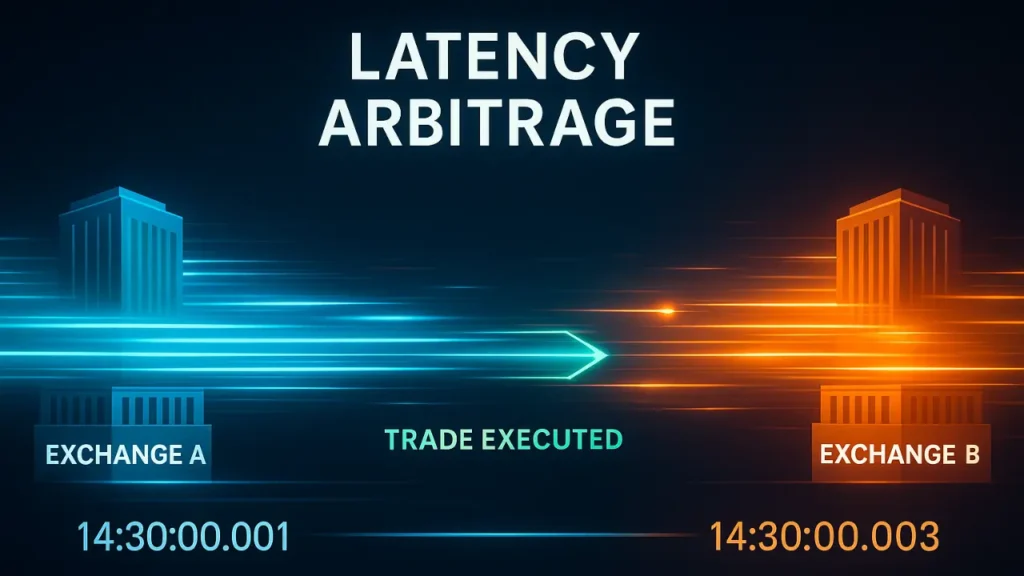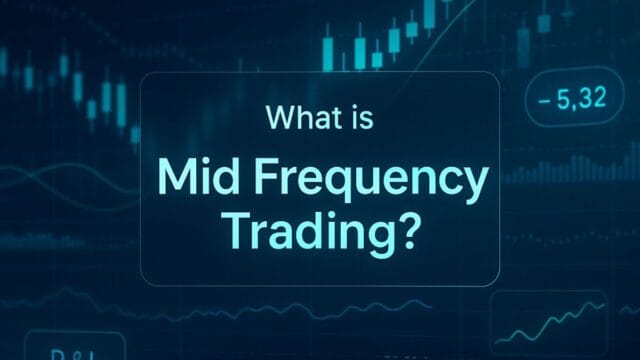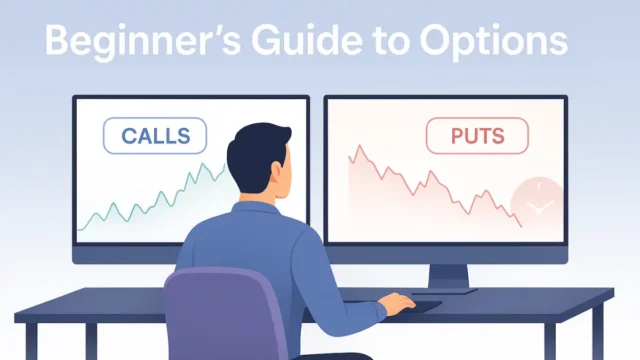Follow Us
What is Latency Arbitrage?

Latency Arbitrage: How High Speed Traders Profit from Market Lag
Imagine two traders executing the same stock order – one profits instantly, while the other barely breaks even. The difference? A few milliseconds.
This is the hidden world of latency arbitrage, a form of high-frequency trading (HFT) that capitalizes on micro-delays in how market data travels between exchanges. In essence, whoever sees the price update first and acts first – wins.
Latency arbitrage may sound like a technical quirk, but it’s one of the most powerful (and controversial) profit engines in modern finance.
Entire hedge funds spend millions shaving microseconds off their trading time, all to capture fleeting price gaps invisible to most investors.
This article breaks down how latency arbitrage works, why it stirs ethical debates, and what it means for everyday traders like you.
Key Takeaways
- Latency arbitrage exploits split-second differences in market data transmission.
- It’s legal but controversial; often seen as a “tax” on slower traders.
- A millisecond edge can translate into millions in profit for high-frequency firms.
- Regulators are responding with “speed bumps” & fairness rules.
- Retail investors can protect themselves by understanding how these mechanics work.
Related Post:
What is Mid Frequency Trading (MFT)? A Practical Guide
What Is Latency Arbitrage?
At its core, latency arbitrage is profiting from time delays in information flow. “Latency” simply means delay, while “arbitrage” means earning from price differences. When combined, it refers to trading strategies that exploit these micro-delays across markets or data sources.
Think of it this way: imagine two live sports feeds, one slightly ahead of the other. If you’re watching the faster stream, you already know who scores before others see it. You could place a bet right before the delayed audience reacts; guaranteed profit.
Now, replace sports with stocks – that’s latency arbitrage.
In financial markets, price updates travel through fiber optics, satellite links, and microwave towers. Even light-speed communication experiences minuscule delays; microseconds, or millionths of a second. High-frequency trading firms build ultra-fast infrastructure, often co-locating their servers directly next to exchange data centers to minimize these delays.
When a price changes on Exchange A, but Exchange B hasn’t yet updated, the latency arbitrageur buys low on one and sells high on the other, all within microseconds.
To human eyes, it’s imperceptible. To machines, it’s a goldmine.
How High Frequency Traders Exploit Latency
Latency arbitrage isn’t random luck, it’s engineered precision. High-frequency traders (HFTs) invest heavily in infrastructure to ensure they are the first to receive & react to market data.
1. Infrastructure Advantage
HFT firms like Jump Trading, Citadel, or Virtu Financial spend millions laying microwave transmission lines between major exchanges (Chicago ↔ New York, London ↔ Frankfurt).
Microwaves travel faster than fiber optics, cutting microseconds off transmission time.
They also rent server space inside exchange data centers, a privilege called co-location; allowing near-instant execution once new data arrives.
2. Algorithmic Speed
Advanced algorithms constantly scan prices across exchanges. When they detect a price discrepancy – say, Apple (AAPL) is $150.00 on NASDAQ but $150.01 on NYSE, the algorithm simultaneously buys from one & sells on the other.
These trades are often risk-free, completed in under a millisecond before others even see the change.
3. “Race Conditions”
Markets operate like a global race; whoever reacts first wins. Latency arbitrageurs capitalize on these race conditions by reacting to stale data before slower participants can adjust.
To them, speed is strategy. Every nanosecond of delay for others is a profit opportunity.
4. Scale & Impact
Even if each trade nets fractions of a cent, HFTs execute millions per day. The aggregate result? Billions in annual profits from essentially being faster than everyone else.
Related Post:
Statistical Arbitrage | Strategies, Tools & How It Works
The Ethical & Regulatory Debate
Latency arbitrage lives in a grey zone between innovation and exploitation.
On one hand, it rewards technological progress – faster networks, smarter algorithms, and more efficient systems.
On the other, it creates an uneven playing field where only firms with deep pockets can compete in microsecond trading.
Critics argue it’s an invisible tax on ordinary traders. Each time a high-speed firm jumps ahead in the queue, slower participants end up paying slightly worse prices.
Multiplied across billions of trades, these micro-costs add up to billions in hidden value transfers.
Real-World Regulation in Action
To address these concerns, regulators and exchanges introduced tools to slow down the fastest traders and level the field:
- IEX’s “Speed Bump”: The Investors Exchange famously delays orders by 350 microseconds, making latency arbitrage virtually impossible.
- SEC’s Market Access Rules: Designed to ensure fair data dissemination & prevent manipulative quote-stuffing.
- European MiFID II Regulations: Require equal data access across participants, limiting structural advantages.
Still, controversy persists. Is latency arbitrage truly harmful or simply the natural evolution of competitive markets?
Supporters claim HFTs add liquidity and stabilize prices by arbitraging inefficiencies quickly. Detractors counter that the liquidity is “phantom”, disappearing when markets turn volatile.
The truth likely lies in between. While speed-based competition isn’t inherently evil, the concentration of advantage among a few powerful firms raises questions about fairness and systemic risk.
Economic Impact & Market Implications
Latency arbitrage’s influence extends far beyond speed itself, it reshapes market microstructure.
1. Liquidity Mirage
High-frequency traders often act as liquidity providers; posting quotes that disappear the moment real demand appears. This creates the illusion of deep markets that can vanish during stress events.
For example, during the 2010 Flash Crash, rapid-fire HFT activity worsened price swings rather than cushioning them.
2. Bid-Ask Spread Compression
On calmer days, latency arbitrage can narrow bid-ask spreads, making markets more efficient.
However, this efficiency is conditional, it benefits markets only when volatility is low and systems remain stable.
3. Retail Investor Impact
Everyday traders rarely compete directly with HFTs, but they may experience subtle disadvantages: slower order fills, small price slippage, or inconsistent quotes.
For long-term investors, these costs are negligible individually, but at scale, they erode confidence in market fairness.
4. Macro-Level Consequences
The race for speed drives enormous investment in non-productive infrastructure – cables, towers, and data centers that don’t improve capital formation or innovation. It’s financial arms racing: high cost, low societal benefit.
How Investors Can Protect Themselves
Latency arbitrage may dominate headlines, but it doesn’t have to dominate your portfolio.
1. Use Limit Orders
Avoid market orders that expose you to fleeting price changes. Limit orders give you control over execution price and reduce the risk of being “picked off” by faster traders.
2. Trade During Stable Periods
High-frequency trading thrives on volatility & fragmented liquidity. Executing trades during calm, high-volume times (e.g., mid-morning) minimizes exposure.
3. Choose Smart Brokers
Some brokers use smart order routing systems that automatically seek the best execution price across exchanges, reducing latency disadvantages.
4. Embrace Awareness, Not Fear
Latency arbitrage doesn’t mean markets are rigged, it just means they’re evolving. Understanding these mechanisms helps you adapt intelligently, not emotionally.
Conclusion
In the modern market, speed is currency.
Latency arbitrage shows how milliseconds can make millionaires and why knowledge is the best defense for the rest of us.
While regulators fight to slow the race, the real power lies in awareness. Understanding how high-frequency traders profit from latency gaps helps investors see markets not as mysterious casinos, but as intricate systems shaped by technology, timing, and competition.
Because in finance — as in life : the fastest edge is often understanding itself.
Disclaimer:
This content is for informational purposes only and should not be considered financial advice.
Read full Disclaimer.




